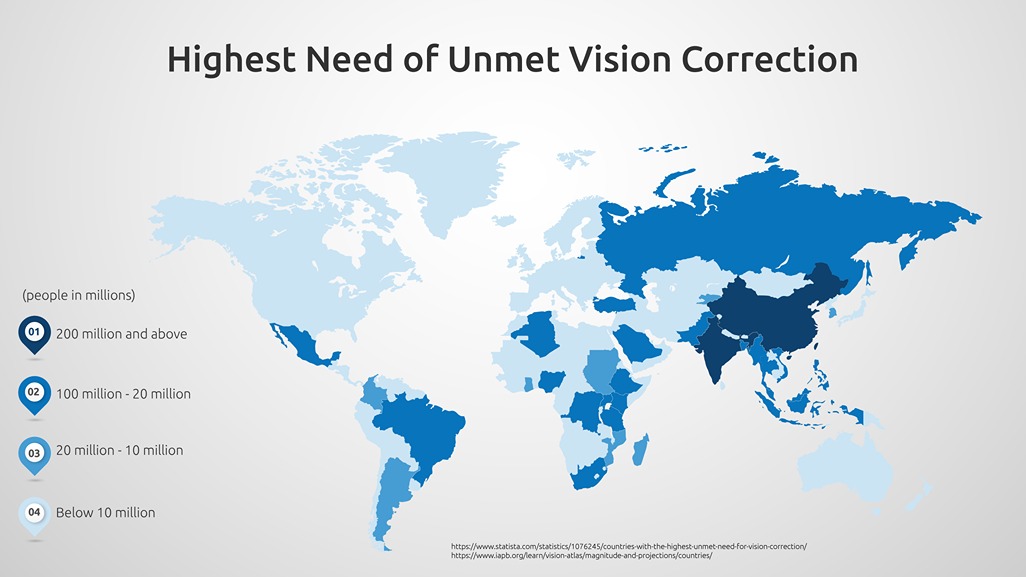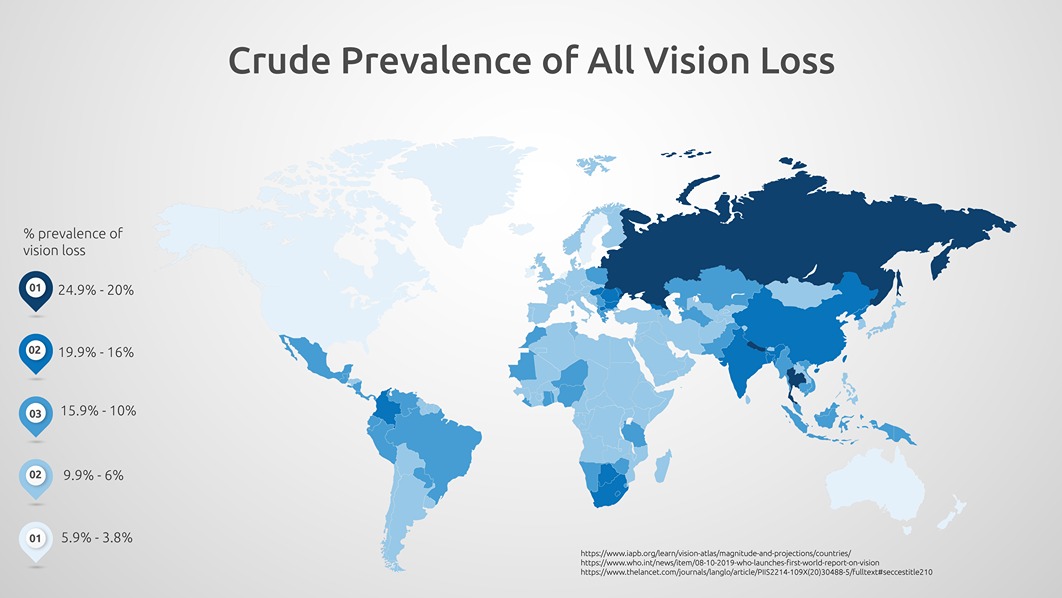How many people in the world have unmet vision correction needs?
Good eye health is widely acknowledged as essential for good quality of life, and for populations to achieve many of the Sustainable Development Goals (SDGs) on the list decided upon by the UN. Despite this, being able to see well is a right that has been denied to many people due to their vision correction needs going unmet. This is despite the fact that in a significant percentage of cases, the conditions that have caused sight loss – whether partial or total – are avoidable, relatively easily treated, and inexpensive for treatment to be administered.
Worldwide statistics reveal that a large percentage of the world’s population has a vision impairment or blindness, with at least half of cases that could have been prevented, or that haven’t been treated or addressed. In this post, we’re going to be taking a look at where the majority of people with unmet needs for vision correction live, as well as the reasons that they are being untreated, and how much money it would take to treat every person that requires treatment.
How many people are impacted by eye conditions worldwide?
- Globally, 1.1 billion people are living with vision loss
- 596 million people worldwide have distance vision impairment
- 43 million people were blind
- 510 million people had uncorrected near vision impairment (could be corrected with reading glasses)
- 90% of affected people live in low-income and middle-income countries (LMICs)
Which countries have the most people with unmet vision correction needs?

- China 720 million (pop: 1.45 billion)
- India 477 million (pop: 1.41 billion)
- Nigeria 95 million (pop: 218.3 million)
- Indonesia 90 million (pop: 280.2 million)
- Brazil 79 million (pop: 216 million)
- Bangladesh 66 million (pop: 168.5 million)
- Mexico 54 million (pop: 132 million)
- Ethiopia 52 million (pop: 121.7 million)
- Pakistan 52 million (pop: 231 million)
- Philippines 51 million (pop: 115.6 million)
- Vietnam 47 million (pop: 98.2 million)
- Thailand 35 million (pop: 70.2 million)
- Tanzania 27 million (pop: 63.9 million)
- South Africa 26 million (pop: 61 million)
- Turkey 25 million (pop: 86.4 million)
- Iran 25 million (pop: 86.5 million)
- Myanmar 24 million (pop: 55.2 million)
- Kenya 24 million (pop: 56.6 million)
- Algeria 20 million (pop: 45.7 million)
- Malaysia 20 million (pop: 34 million)
- Uganda 20 million (pop: 49.3 million)
- Uzbekistan 18 million (pop: 34.6 million)
- North Korea 18 million (pop: 26 million)
- Colombia 18 million (pop: 52.1 million)
- Argentina 17 million (pop: 46.2 million)
- Sudan 15 million (pop: 46.3 million)
- Ghana 14 million (pop: 32.6 million)
- Mozambique 13 million (pop: 33.4 million)
- Madagascar 12 million (pop: 29.4 million)
Which countries have the most people with all vision loss?

When it comes to total sight loss, the countries with by far the largest populations of people are Russia, Nepal, and Thailand, with between 20% and 24.9% of the population being affected. This is followed by Colombia, Romania, Bulgaria, South Africa, Botswana, India and China, all of which have between 16% and 19.9% of the population with all vision lost.
Research from the World Health Organisation shows that low- and middle-income regions of western and eastern sub-Saharan Africa and South Asia have rates of blindness that are eight times higher than in all high-income countries.
Why do countries have so many people with unmet vision correction or vision loss?
The reasons for these countries having such high numbers of unmet vision correction, or complete sight loss are complex. In Algeria, Colombia, Ghana, Ethiopia, Mexico, Mozambique, Myanmar, Nigeria, Sudan, and Tanzania there are ongoing conflicts and terrorist insurgency, which are likely to play a part in people seeking help. Many of these countries are also amongst the poorest in the world, and so for many families, healthcare, or the ability to afford to travel to obtain healthcare, simply isn’t an option.
What are the causes of preventable vision impairment?
Vision impairment and blindness can be caused by many different illnesses and conditions, with around half caused by conditions that cannot be treated. Globally, the leading causes of vision impairment are uncorrected refractive errors, cataracts, age-related macular degeneration, glaucoma, diabetic retinopathy, corneal opacity, and trachoma.
There are a number of conditions that can be prevented from occurring and certainly prevented from leading to complete blindness if early interventions are accessed. Examples of such conditions include:
- Cataract
- Trachoma
- Refractive error
- Myopia
- Diabetic retinopathy
Other conditions that can impact the eyes, such as dry eye and conjunctivitis should also be included in healthcare research, since they are often the main reasons that patients seek help with their eye health. Where access to eye care services is difficult, such as for the population of remote areas, people are often unable to access routine checks that would uncover their condition in good time and allow them to access the treatment that they need.
Late detection is a huge challenge for eyecare professionals and the wider health service, since preventative care and early treatment can stop the issues from becoming a bigger problem for the individual, and for them to lose their sight completely. Where treatment is sought in later stages of the condition, often the damage is irreversible, resulting in them requiring more expensive treatments and longer-term care.
How can we prevent blindness and vision impairment?
Access to services at the primary health care level is the key to preventing conditions leading to complete loss of vision. With early detection, many issues are treatable and are much less likely to lead to blindness. This means that eye tests, prescription glasses, and contact lenses, as well as cataract surgery should be available to as many people as possible to help prevent further vision impairment. Prevention, early detection, treatment, and rehabilitation are all relatively inexpensive, compared with the cost to the person and their families – especially with the additional health problems that may occur due to their sight loss.
How much would it cost to treat everyone with vision impairment?
People affected by loss of sight due to short and farsightedness, and cataracts could be treated relatively straightforwardly – either with a cataract operation, or with a pair of glasses. Approximately $14.3 billion (US) would be required to treat the one billion people already living with this type of vision impairment. Divided by the entire population of the world, this would cost less than $2 per person.
How can people already living with blindness and severe vision impairment be supported?
Not all people with blindness or vision impairment can be treated. But many people who are living with blindness and severe vision impairment want to live as independently as possible – and in many cases, will have developed their own coping mechanisms and support strategies. But today there are more ways than ever that people living with any kind of vision impairment can be supported.
Rehabilitation services can’t reinstate the patient’s sight, but help them to come to terms with their sight loss, as well as training them to use assistive aids such as optical magnifiers, orientation and mobility training with white canes and guide dogs, as well as reading using Braille.
Where smartphones are available or are feasible for patients financially, they may also be trained in using wayfinders and maps. Technology developments in smartphones and PC technology have made it easier than ever for people with vision impairment to go about their daily lives. Accessibility features such as screen readers, ‘senior mode’, high contrast and large font settings, and voice controls are all built into most operating systems as standard today.
How can I support people living with blindness and severe vision impairment?
There are a number of charities worldwide that aim to provide treatment and support for people living with blindness and severe vision impairment, with some working towards supporting certain conditions, some in certain countries. Vision Aid Overseas, Sightsavers, and Orbis all work internationally, but you can find other charities on the list from The Royal College of Ophthalmologists.
Sources
International Agency for the Prevention of Blindness Vision Atlas
The Lancet
The Royal College of Ophthalmologists
The UN
World Health Organisation
World Health Organisation
World Population Review
Author: John Dreyer Optometrist Bsc(Hons), MCOPTOM, DipCLP
Created: 30 Oct 2022, Last modified: 7 Jan 2025

